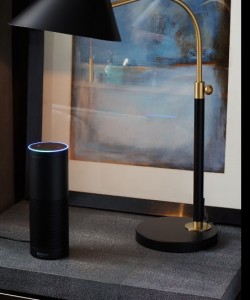 I almost bought an Amazon Echo last November. It was on sale for $129, and I figured it was too good a deal to pass up.
I almost bought an Amazon Echo last November. It was on sale for $129, and I figured it was too good a deal to pass up.
Amazon promised two-day Prime delivery, but they got overwhelmed by all the orders and, as with many others, they botched mine and said I might receive it by end of year. At that point I decided it wasn’t meant to be, so I cancelled. I’m glad I did.
I already have a couple of other terrific Bluetooth speakers, and while the Alexa voice control feature is nice, I’m not convinced it’s worth $100+. It reminds me of dedicated GPS devices and fitness bracelets, both of which have been replaced by sensors in my phone.
Echo is more of a nice-to-have, not need-to-have, item for me, especially with its ability to turn news and other types of written content into streamable audio content. But I’m much more interested in a mobile solution, not one that sits on a countertop.
Like GPS and fitness devices, Echo’s main functionality will also eventually find its way into the phone itself. The reason I’m prefer a mobile solution is that I spend a lot of time in my car where I use the Bluetooth feature of my radio and phone to listen to podcasts, music, etc.
The Echo platform becomes very attractive to me when it’s nothing more than an app on my phone that plays through my car radio. The app handles all the speech command conversion via the cellular connection, the same way the streaming content arrives.
This app doesn’t have to be free, by the way. Charge me $5/month or something close to that, and I’ll gladly pay for the option to “play news” and other commands in my car.
Where this really gets fascinating is with longer-form content and the ability to use voice commands to annotate and highlight audio books, for example. Whether it’s in my car or at home, it would be nice to finally have the ability to do more than just listen to an audio book. For example, when I hear a noteworthy passage, I’d like to be able to say “pause”, “highlight last two sentences,” “add private note to highlight saying ‘this is something I should pass along to the marketing team,’” etc.
Take it a step further and integrate my email app so that rather than just making that verbal note to pass along to marketing, let me say, “create email to Joe Smith at company.com, subject ‘key discovery,’ body is highlight, send.”
Let’s say you’re listening to that book and you hear a phrase, person or location you’re not familiar with. The app should have the ability for me to say, “pause”, “tell me about phrase/person/location” and the app responds with the appropriate audio stream (e.g., top Google search result, Wikipedia entry, etc.)
All my audio highlights and annotations must be searchable, by voice as well as text. In fact, let’s add the capability to integrate all these highlights and notes into Evernote so I can keep everything in one place.
Amazon might be happy selling $100+ voice-controlled Bluetooth speakers today; but the real opportunity is with a fully mobile, app-driven solution that integrates with a broader number of content sources and streams. We’re not there yet; but by combining voice control and streaming audio, the Amazon Echo platform is starting to show us what’s possible down the road.
(Reproduced with permission from Joe Wikert’s Digital Content Strategies.)





























I think where the Echo shines is with home automation. Prior to the addition of home automation, the “Bluetooth speaker” functionality of Echo was kind of cute, but not worth the asking price. Home automation changed everything and that was when I bit the bullet and bought one.
Yes, home automation can be controlled by a cell phone or tablet, but then you have to have it with you when you want to turn on lights, turn off lights, dim lights, brighten lights, set the thermostat, turn on the TV. And finding your phone, starting an app, and navigating it to turn on/off what you want is usually more work than just walking to a switch. But saying “Echo, turn off the lights” on my way to the bedroom is super easy.
And with Alexa added to our FireTVs, we have access to that home automation from the center of the house via the Echo, from any room with a TV via the FireTV (although you need the remote), and now with the addition of the dot, you can extend the Echo into other rooms for half the current price. I have a Dot on pre-order and if it works well, we will eventually likely add enough DOTs to cover the major rooms in our home.
Once you have home automation, then the additional blue tooth speaker voice automation options become the icing on the cake. I wake up in the morning, have Echo turn on the kitchen lights, ask Echo about the weather so I know what to wear, ask Echo when the Cubs play to get details of today’s sporting events, and I can tell it to play some Nirvana from Prime while I make my kids breakfasts and lunches. If I am running low on OJ, I just tell Echo to add it to the shopping list – no more forgetting to buy things because my phone or shopping list wasn’t handy at the time I realized I needed to add something. All this before I have even found my phone in the morning.